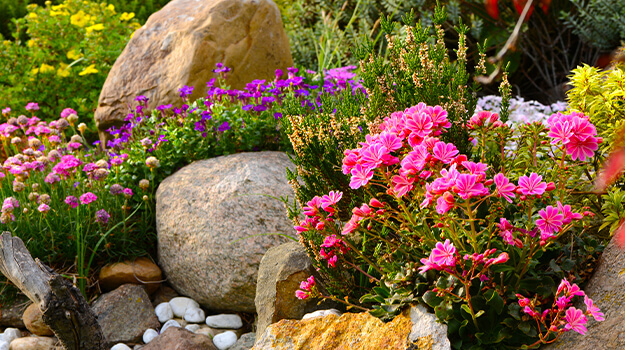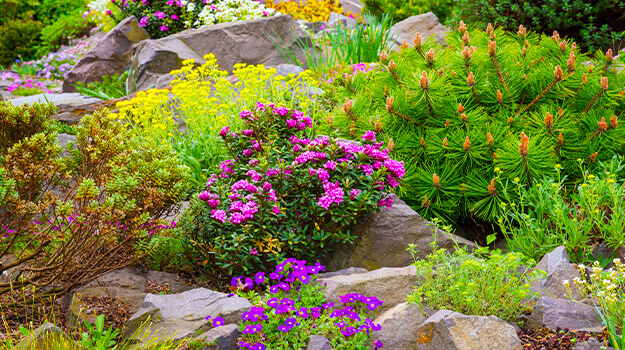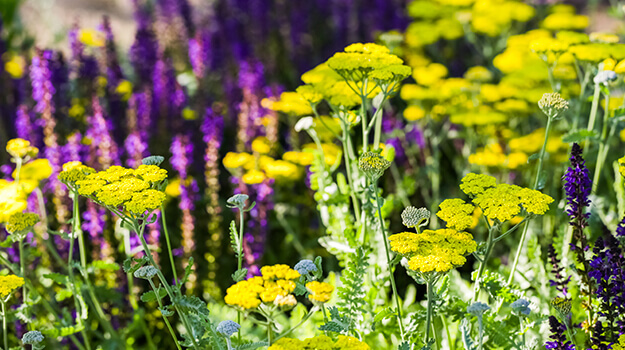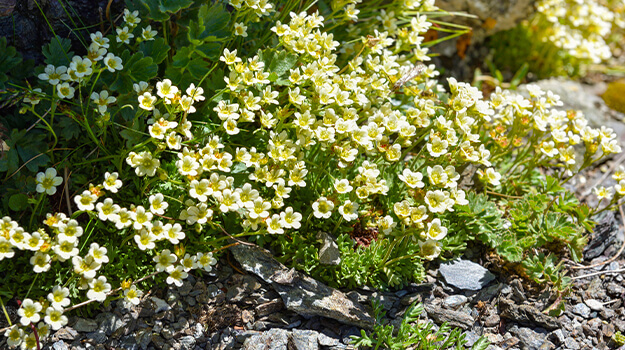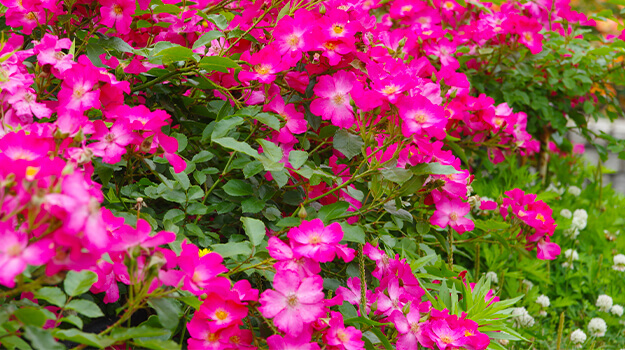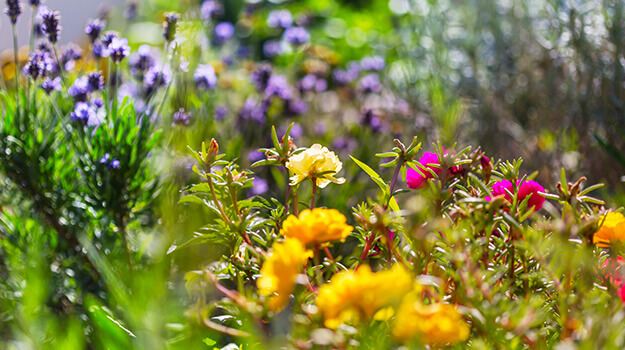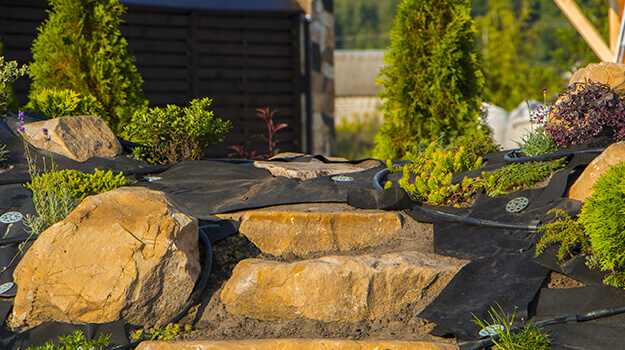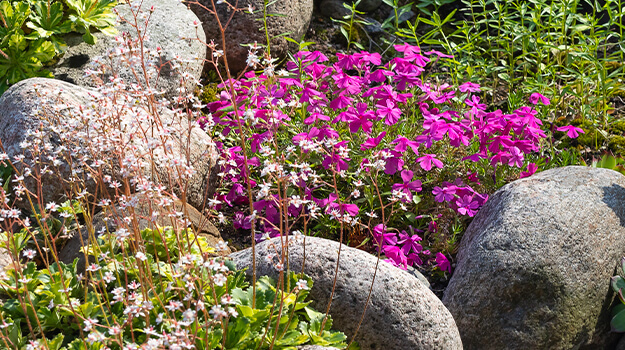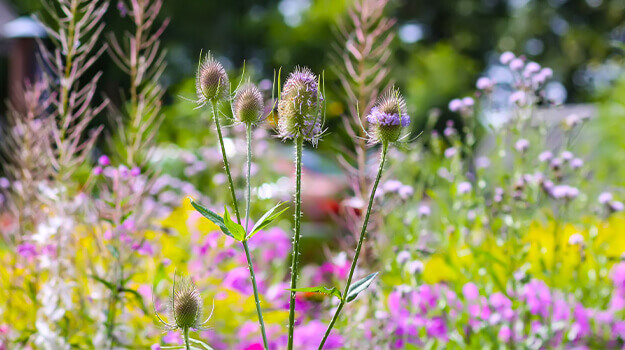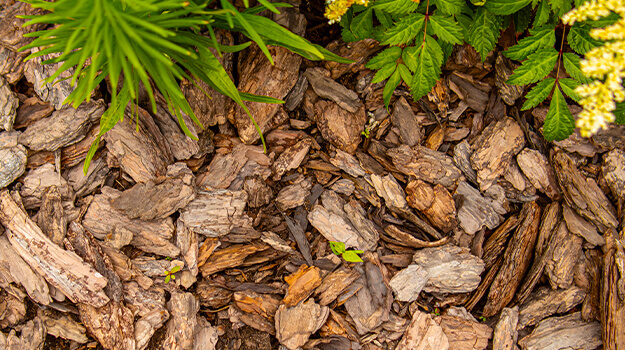A rockery is a landscaped area made of gravel, rocks or boulders, perennial and annual plants, grass flowers or shrubs, adapted to their environment. Its appeal lies in the harmonious combination of elements and the way they are arranged for a natural effect.
How to successfully create a rockery?
- Combine rocks of different sizes and shapes, but ideally of the same composition. Choose similar colours and textures to ensure uniformity. This will allow you to incorporate a greater variety of plants.
- For a natural effect, avoid placing flowers in rows. Also avoid creating patterns around rocks.
- Rockeries are not just about a collection of creeping plants. Choose plants of varying heights, combining perennials, ornamental grasses, small shrubs and ground covers.
- Play with contrasts with plants of different shapes and textures.
- Use repetition (shapes, colours, varieties).
The best plants for a rockery
There are no "rockery plants" as such. Rather, they are plants that share specific characteristics that allow them to thrive in rock gardens.
- Resistance to drought (check out our list of the best drought-tolerant plants)
- Preference for well-drained soils (especially if there are significant level differences)
- Compact habit
Then, as with any flower bed, you must choose plants that have the same needs in terms of water, fertilizer and sunlight.
The best plants for an alpine garden
Alpine plants are a botanical category that is defined by their habitat, mountainous regions, or rather the characteristics that allow them to survive in the harsh conditions prevailing there.
Resistant and resilient, they are well-suited to extreme temperatures, strong sunlight, strong winds and poor soil. In short, in our gardens, they are considered easy-to-grow, low-maintenance plants. They also have a small size, making them ideal for rockeries or alpine gardens.
This category includes virtually all types of plants: small and medium-sized perennials, ornamental grasses, succulents, herbaceous and creeping plants, small shrubs, dwarf conifers and hardy creeping or ground cover roses, such as the Canadian Alba Meidiland rose or the Flower Carpet roses.
Both to add colour throughout the season and to fill empty spaces in the first few years, you can add annual grasses or low or creeping annual flowers whose habit is reminiscent of alpine plants.
Regardless of the type of plants chosen, avoid planting on impulse. For a natural and harmonious effect, the plants chosen should not clash with a rocky landscape. Varieties with small, downy, glaucous or greyish foliage should be preferred.
How to recognize an alpine plant at the garden centre
Growers don't necessarily make a distinction between rock garden plants and alpine garden plants, as their characteristics are similar. In garden centres, these plants are grouped under different names: rock garden plants, low wall plants, creepers and ground cover plants.
What are the characteristics of alpine plants?
Alpine plants are plants that have evolved to survive in extreme conditions. Their main characteristics are:
- Increased resistance to extreme temperatures, wind and snow
- Generally small, thick and sturdy leaves that retain moisture
- Slow growth
- Small size to benefit from the snow cover
- A robust root system that allows them to anchor themselves firmly, even in rocky soil
- Effective reproductive strategies to persist despite short periods of growth
Creating an alpine garden or rockery in 8 steps
1. Determine the location of the rockery
Just like a xeriscape, a rockery can be created on a steep or gentle slope, in a hard-to-reach area or even on a flat area. It's an excellent option to beautify a ditch or create a demarcation between the house and the driveway or at the border of a neighbour's property.
2. Draw up a plan or sketch of the layout
This is more about determining the approximate location of stones and plants than drawing an exhaustive plan. Consider the size of the stones you plan to use to determine planting areas.
If your flower bed is on a slope, position the rocks so they hold the soil in place. (Planting erosion control plants can also help prevent the soil from shifting during heavy rains.)
3. Prepare the area
Remove any grass, weeds or plants and loosen the soil. Depending on the type of plants removed, they can be used in the rockery or placed in another flower bed. If they're a good size, take the opportunity to divide them. You'll get more plants for your landscaping!
4. Place the rocks
For a natural effect, avoid arranging rocks in rows unless the rockery has significant level differences. When the slope is steep, they can be placed to mimic a staircase, with the flat surfaces reserved for planting. Not only will this hold the soil better, but water will also stay on it longer. To break up the pattern, use stones of different shapes and sizes. The effect will be more natural.
Don't hesitate to turn the rocks over to find their most appealing side. Some will be placed directly on the ground on their flat side, others will be partially buried in the ground. Remember that you will have to access the rockery to plant or weed. Make sure the stones are stable.
5. Amend the planting soil
Prepare the soil by incorporating a quality soil mix. Choose a nutrient-rich soil with sphagnum peat moss that enriches and improves soil structure while providing good water retention and drainage, such as our Premium All Purpose Mix.
Our MYCOACTIVE growth stimulant promotes root development for a faster establishment and a thicker root system. Not only will your plants be better anchored, but they will also be able to better absorb water and nutrients.
6. Choose your plants
Choose rockery or alpine garden plants that have similar needs, particularly in terms of water and sunlight.
Check out our list of the best plants for alpine or rockeries.
Also consider integrating plants with attractive foliage colour, as alpine plants generally have abundant but brief flowering (some bloom longer than others).
7. Plant
Group small plants together and plant them in odd numbers. This prevents a chaotic effect. Also, use repetition (same variety but different flower colours, different varieties but similar colours). Also, limit the number of colours and create beautiful harmonies. (Learn how to match colours in our article.)
If your landscaping is located in a hard-to-reach area, opt for fast-growing plants rather than cheating on the recommended planting space. Dividing or removing plants on a slope is a more difficult task than removing weeds.
8. Add a ground cover
Using a ground cover helps limit weed growth and recreate the natural look sought after in this type of landscaping. Mother Nature rarely leaves the ground bare.
Decorative bark nuggets and cedar chips are ideal for a rock garden featuring dwarf evergreens, shrubs, roses, grasses and ground cover plants. Decorative rocks, ideal for xeriscaping, and finer mulches are more suitable for smaller perennials and annuals.
TIP: As a natural effect is desired here, choose a natural or black cedar mulch.

